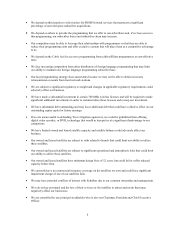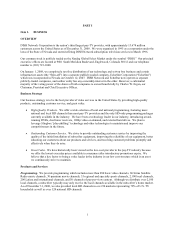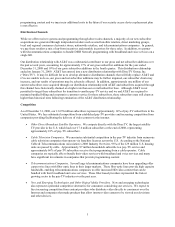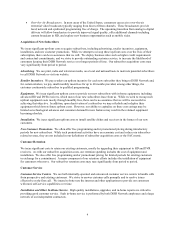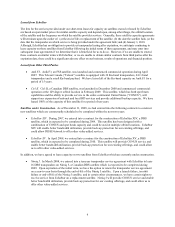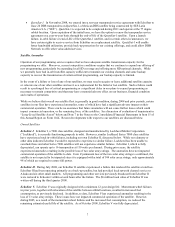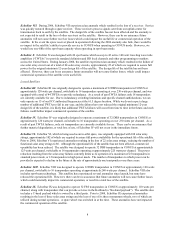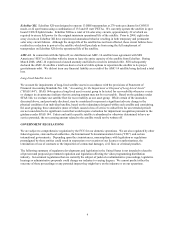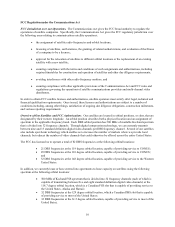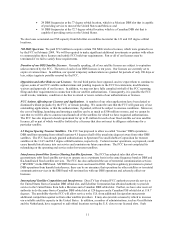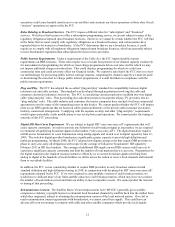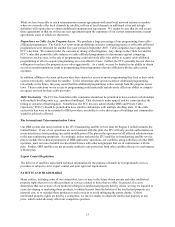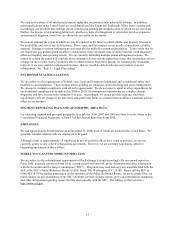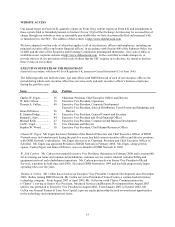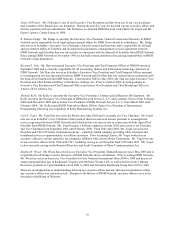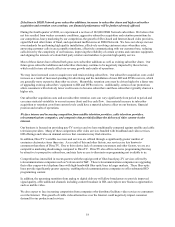Dish Network 2008 Annual Report Download - page 18
Download and view the complete annual report
Please find page 18 of the 2008 Dish Network annual report below. You can navigate through the pages in the report by either clicking on the pages listed below, or by using the keyword search tool below to find specific information within the annual report.8
EchoStar VII. During 2006, EchoStar VII experienced an anomaly which resulted in the loss of a receiver. Service
was quickly restored through a spare receiver. These receivers process signals sent from our uplink center for
transmission back to earth by the satellite. The design life of the satellite has not been affected and the anomaly is
not expected to result in the loss of other receivers on the satellite. However, there can be no assurance future
anomalies will not cause further receiver losses which could impact the useful life or commercial operation of the
satellite. In the event the spare receiver placed in operation following the 2006 anomaly also fails, there would be
no impact to the satellite’s ability to provide service to CONUS when operating in CONUS mode. However, we
would lose one-fifth of the spot beam capacity when operating in spot beam mode.
EchoStar X. EchoStar X was designed with 49 spot beams which use up to 42 active 140 watt traveling wave tube
amplifiers (“TWTAs”) to provide standard definition and HD local channels and other programming to markets
across the United States. During January 2008, the satellite experienced an anomaly which resulted in the failure of
one solar array circuit out of a total of 24 solar array circuits, approximately 22 of which are required to assure full
power for the original minimum 12-year design life of the satellite. The design life of the satellite has not been
affected. However, there can be no assurance future anomalies will not cause further losses, which could impact
commercial operation of the satellite or its useful life.
Leased Satellites
EchoStar III. EchoStar III was originally designed to operate a maximum of 32 DBS transponders in CONUS at
approximately 120 watts per channel, switchable to 16 transponders operating at over 230 watts per channel, and was
equipped with a total of 44 TWTAs to provide redundancy. As a result of past TWTA failures only 18 transponders
are currently available for use. Due to redundancy switching limitations and specific channel authorizations, we can
only operate on 15 of our FCC authorized frequencies at the 61.5 degree location. While we do not expect a large
number of additional TWTAs to fail in any year, and the failures have not reduced the original minimum 12-year
design life of the satellite, it is likely that additional TWTA failures will occur from time to time in the future, and such
failures could further impact commercial operation of the satellite.
EchoStar IV. EchoStar IV was originally designed to operate a maximum of 32 DBS transponders in CONUS at
approximately 120 watts per channel, switchable to 16 transponders operating at over 230 watts per channel. As a
result of past TWTA failures, only six transponders are currently available for use. There can be no assurance that
further material degradation, or total loss of use, of EchoStar IV will not occur in the immediate future.
EchoStar VI. EchoStar VI, which is being used as an in-orbit spare, was originally equipped with 108 solar array
strings, approximately 102 of which are required to assure full power availability for the operational life of the satellite.
Prior to 2008, EchoStar VI experienced anomalies resulting in the loss of 22 solar array strings, reducing the number of
functional solar array strings to 86. Although the operational life of the satellite has not been affected, commercial
operability has been reduced. The satellite was designed to operate 32 DBS transponders in CONUS at approximately
125 watts per channel, switchable to 16 transponders operating at approximately 225 watts per channel. The power
reduction resulting from the solar array failures currently limits us to operation of a maximum of 25 transponders in
standard power mode, or 12 transponders in high power mode. The number of transponders to which power can be
provided is expected to decline in the future at the rate of approximately one transponder every three years.
EchoStar VIII. EchoStar VIII was designed to operate 32 DBS transponders in CONUS at approximately 120 watts
per channel, switchable to 16 transponders operating at approximately 240 watts per channel. EchoStar VIII also
includes spot-beam technology. This satellite has experienced several anomalies since launch, but none have
reduced the operational life. However, there can be no assurance that future anomalies will not cause further losses
which could materially impact its commercial operation, or result in a total loss of the satellite.
EchoStar IX. EchoStar IX was designed to operate 32 FSS transponders in CONUS at approximately 110 watts per
channel, along with transponders that can provide services in the Ka-Band (a “Ka-band payload”). The satellite also
includes a C-band payload which is owned by a third party. Prior to 2008, EchoStar IX experienced anomalies
resulting in the loss of three solar array strings and the loss of one of its three momentum wheels, two of which are
utilized during normal operations. A spare wheel was switched in at the time. These anomalies have not impacted
the commercial operation of the satellite.



